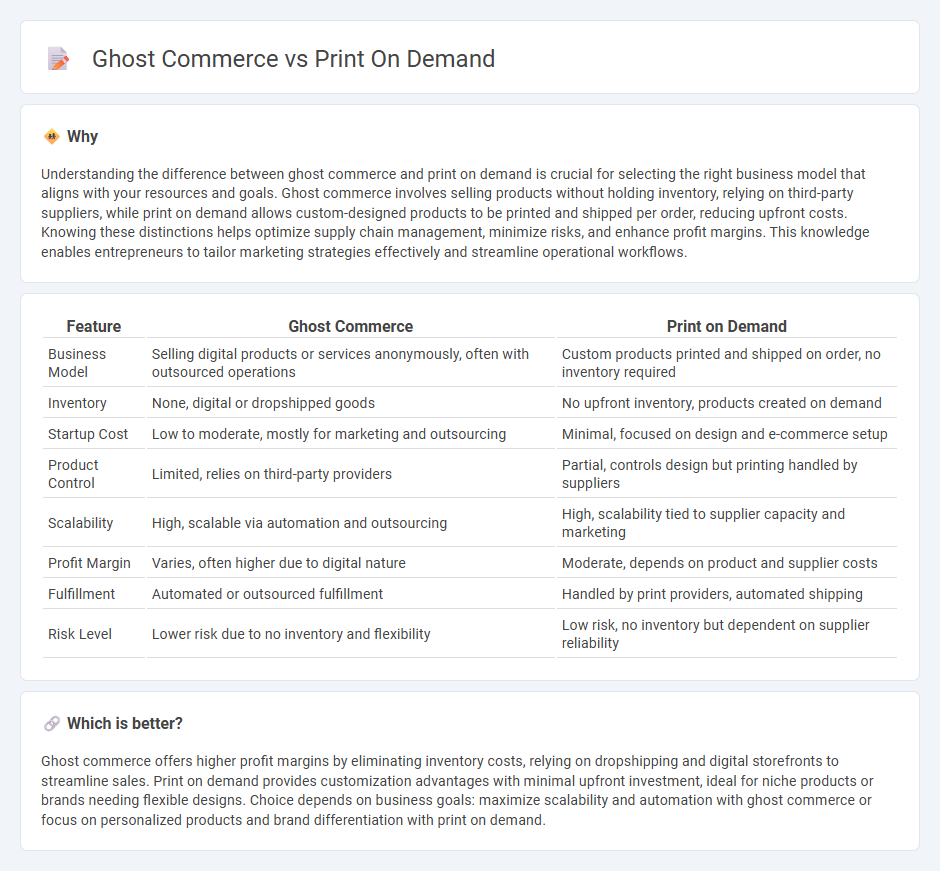
Ghost commerce enables businesses to sell products without managing inventory or fulfillment, leveraging third-party services to handle production and shipping. Print on demand specifically focuses on custom-designed products printed only after an order is placed, reducing upfront costs and minimizing waste. Explore the differences and advantages of ghost commerce versus print on demand to optimize your e-commerce strategy.
Why it is important
Understanding the difference between ghost commerce and print on demand is crucial for selecting the right business model that aligns with your resources and goals. Ghost commerce involves selling products without holding inventory, relying on third-party suppliers, while print on demand allows custom-designed products to be printed and shipped per order, reducing upfront costs. Knowing these distinctions helps optimize supply chain management, minimize risks, and enhance profit margins. This knowledge enables entrepreneurs to tailor marketing strategies effectively and streamline operational workflows.
Comparison Table
| Feature | Ghost Commerce | Print on Demand |
|---|---|---|
| Business Model | Selling digital products or services anonymously, often with outsourced operations | Custom products printed and shipped on order, no inventory required |
| Inventory | None, digital or dropshipped goods | No upfront inventory, products created on demand |
| Startup Cost | Low to moderate, mostly for marketing and outsourcing | Minimal, focused on design and e-commerce setup |
| Product Control | Limited, relies on third-party providers | Partial, controls design but printing handled by suppliers |
| Scalability | High, scalable via automation and outsourcing | High, scalability tied to supplier capacity and marketing |
| Profit Margin | Varies, often higher due to digital nature | Moderate, depends on product and supplier costs |
| Fulfillment | Automated or outsourced fulfillment | Handled by print providers, automated shipping |
| Risk Level | Lower risk due to no inventory and flexibility | Low risk, no inventory but dependent on supplier reliability |
Which is better?
Ghost commerce offers higher profit margins by eliminating inventory costs, relying on dropshipping and digital storefronts to streamline sales. Print on demand provides customization advantages with minimal upfront investment, ideal for niche products or brands needing flexible designs. Choice depends on business goals: maximize scalability and automation with ghost commerce or focus on personalized products and brand differentiation with print on demand.
Connection
Ghost commerce leverages print on demand by enabling entrepreneurs to sell customized products without maintaining inventory, streamlining operational costs and reducing risk. Print on demand's technology integrates seamlessly with ghost commerce platforms, allowing real-time product creation and direct shipping to consumers. This synergy enhances scalability and flexibility for online businesses, driving growth through personalized merchandise.
Key Terms
Inventory management
Print on demand eliminates inventory risks by producing products only after an order is placed, reducing upfront costs and storage needs. Ghost commerce requires careful inventory management to handle stock levels without traditional storefront constraints, balancing supply and demand efficiently. Explore further to understand which model best suits your business goals and operational capabilities.
Branding
Print on demand empowers entrepreneurs to build distinctive brands through customizable products without upfront inventory costs, enhancing customer loyalty and recognition. Ghost commerce leverages existing platforms and curated selections, focusing on rapid scaling with less emphasis on unique branding elements. Explore how strategic branding in print on demand can transform your business identity and long-term success.
Order fulfillment
Print on demand streamlines order fulfillment by integrating custom printing and direct shipping, reducing inventory costs and minimizing risks. Ghost commerce relies on third-party suppliers to handle storage and distribution, which can introduce delays but allows for greater product variety without upfront investment. Explore the key differences in order fulfillment strategies to optimize your e-commerce operations.
Source and External Links
What Is Print on Demand and How To Start a Business (2025) - Print on demand is a business model where products are designed by the seller and produced by the supplier only after a customer orders, eliminating inventory and upfront costs, with the process including design creation, product selection, listing for sale, order fulfillment, and shipping directly to customers.
Print on Demand for Individuals and Brands | 370+ Products - Print on demand allows individuals and businesses to create custom products using their own designs with no minimum order; products are printed, packaged, and shipped after purchase, offering a low-risk way to run ecommerce businesses with global reach and quality assurance.
Print on Demand & DropShipping Platform | 1000+ products - Printify - Printify offers a print-on-demand platform that enables sellers to launch and grow their ecommerce businesses with 1300+ customizable products, zero upfront investment, and automated order fulfillment, targeting creators, entrepreneurs, and brands alike.
 dowidth.com
dowidth.com